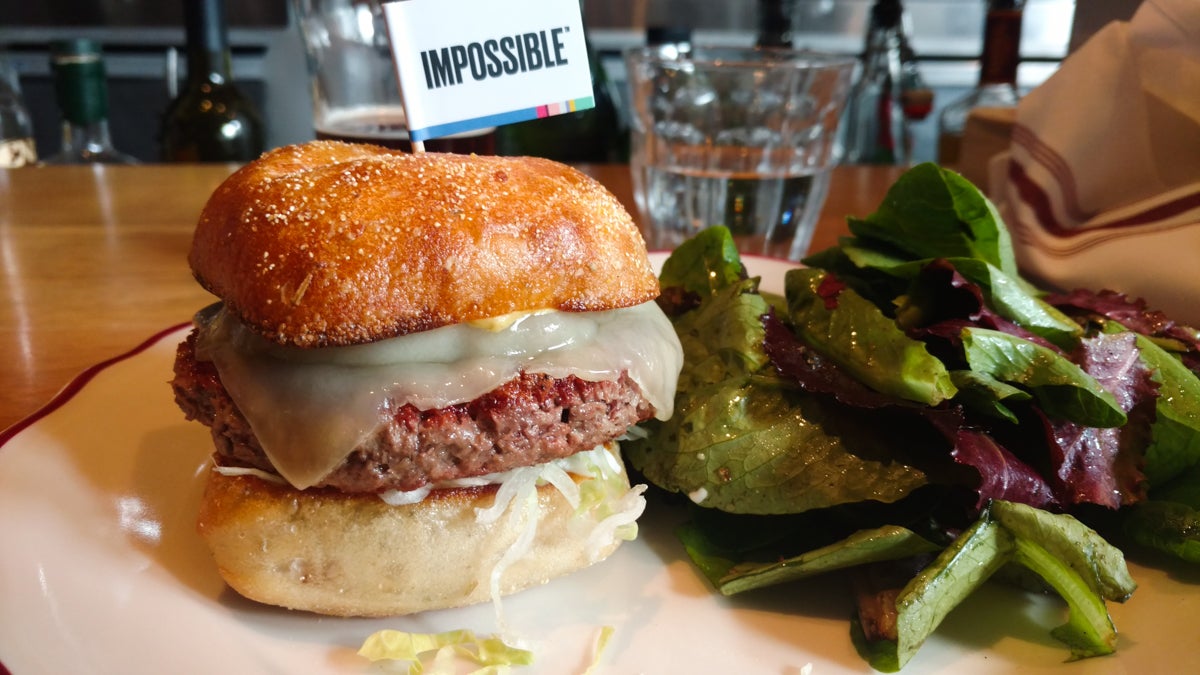Scientists are fine-tuning a fake meat burger that ‘bleeds’
Listen
Impossible Foods derives heme from yeast through fermentation, so that its plant burger "bleeds" too. (Andrew Stelzer/for WHYY)
There’s been quite a buzz in the San Francisco Bay Area recently about something called ‘The Impossible Burger’. Impossible because it tastes like meat, but it’s not meat.
Cockscomb—a trendy, foodie spot in San Francisco’s South of Market neighborhood–is one of six restaurants in the country that serves the Impossible Burger.
I invited my friend Sara Booth along for the taste test. A meat-eating Jersey girl, she was skeptical about the whole thing.
“It’s never gonna taste as good as a juicy burger,” she said. “‘Cause it’s an imitation, it’s not the real thing!”
Sitting a few stools down, Neumann Vong was also waiting for his first Impossible Burger. He said he was trying it in order to report back to a friend.
“I’m a meat eater. But I’m just curious to see what the state of the art in meatless meat is,” Vong said.
Making it sizzle
The burger is made from wheat, potatoes, and coconut oil. Plants that are higher in saturated fat are more likely to give you a “mouth-feel” similar to meat. One of the key ingredients in the burger is something called “heme”—or leghemoglobin. Heme is a compound containing iron that’s in many plants.
Impossible Foods derives heme from yeast through fermentation, so that its plant burger “bleeds” too. The theory is, that red, blood-like drip is something meat eaters want. Cockscomb’s maître d’ Steven Oliver said the restaurant has served 3,000 burgers since October, and 80 percent of people who come in for one are carnivores like me.
“I think there is a want and a need out there for people to find meat substitutes because it affects our environment, affects water, especially being in California,” Oliver said.
The taste test
On its website, Impossible Foods says its burger uses a small fraction of the amount of land and water as cows raised for cattle, and creates 87 percent less greenhouse gas emissions. But the big question is: ‘How does it taste?’
When the waiter brought our order, it looked like a juicy burger. When I bit into it, it was a bit softer than a traditional hamburger, but some kind of red “burger juice” ran down my chin.
Sara and I both gave it an “A” for taste.
The Impossible Burger is 19 bucks–including a small salad. That high price may come from the cost of engineering high-quality meatless meat. Creating and fine-tuning the burger took two years and was funded by almost $200 million from investors like Bill Gates and Google Ventures.
Designing, selling a believable fake
Across the San Francisco Bay Bridge, at the University of California at Berkeley, I visited the Challenge Lab at the Sutardja Center for Entrepreneurship & Technology. The students are angling to be the next person to break into the rapidly growing plant-based meat industry.
Guest lecturer Chef Dave Anderson passed around two types of chicken strips, one real and a chicken-less version made by a company he used to work for, called Beyond Meat.
“So here’s the issue,” Anderson said. “Chicken has chicken flavor whether it has salt or not, right? But the process that these flavor companies are using to create chicken flavor produces a lot of salt too. So if you want to amp up the chicken flavor you are taking a whole bunch of salt with it too.”
The 40 or so students in the class tried both versions.
“I think the flavor wasn’t there. It didn’t seem a lot like chicken,” Nathan Sumac said.
“Oh, I love it. I’m really struck by how it peels and how fibrous the mixture is,” said Etisha Lewis, a business major who used to run a vegan bakery in Brooklyn, New York.
Fake meat is a growing market. Allied Market Research predicts that by the year 2020, the global meat substitute market will be worth more than $5 billion a year.
“What I’ve learned is it does take a lot of upfront investment to get an extruder and get you know, a team of scientists together who actually know how to mimic the flavor and the texture of meat.”
At the end of the semester, the students with the best idea for a plant based meat will get $5,000, and a meeting with venture capitalists.
Chef Anderson, who’s spent the last 15 years designing meat alternatives, says much of the work is constantly tweaking variables like taste, nutritional value, and cost.
“We would have a meeting, ‘So it needs more beef flavor,'” Anderson said. “So I’d crank up the beef flavor and the moisture would go to hell. And I would run the cost of it and it would cost twice as much as it was supposed to. So it’s this crazy balancing act.”
Searching for the Hoy Grail of Plant-Based Meat
Kenji Lopez-Alt is author of “The Food Lab: Better Home Cooking Through Science.” He says scientists are looking for plant proteins that can mimic the texture and qualities of animal protein.
“Meat is muscle and muscle is designed to stretch and contract, and designed to be very tough,” Lopez-Alt said.
“Plants on the other hand are stationary, and so plant cells are designed to be sort of more like, you can think of them more like cinder blocks. They’re, they’re very sturdy, but they’re not very stretchy or very pliable,” he said.
The fake meat industry is just getting started. Lopez-Alt compared it to movie special effects in the 1980s, which were cool back then, but pretty lame compared to the 3-D blockbusters we see on the big screen today.
Wait a bit. That veggie burger is only going to get better.
WHYY is your source for fact-based, in-depth journalism and information. As a nonprofit organization, we rely on financial support from readers like you. Please give today.



